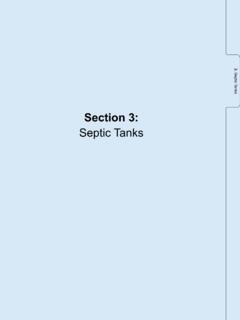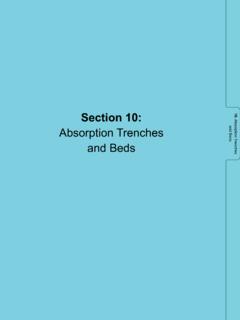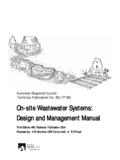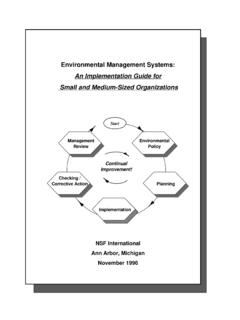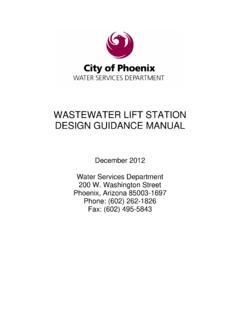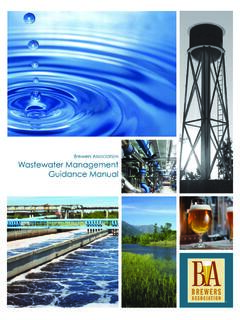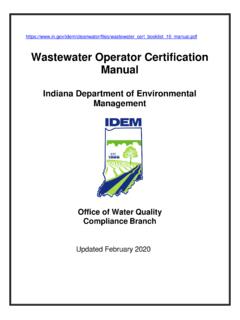Transcription of Designing and Installing On-Site Wastewater Systems
1 Designing and Installing On-Site Wastewater Systems A WaterNSW Current Recommended Practice Document Control Version Date Document Administrator Peer Review Draft June 2010 Planning and Assessments, SCA. Industry Review Draft May 2011 Planning and Assessments, SCA. Publication May 2012 Planning and Assessments, SCA. Publication November 2019 Catchment Protection, WaterNSW. (Peer reviewed). Acknowledgements Designing and Installing On-Site Wastewater Systems ' (the manual ) was developed by WaterNSW with contributions by Joe Whitehead of Whitehead &. Associates Environmental Consultants Pty Ltd and Kerry Flanagan of Kerry Flanagan Wastewater . Disclaimer This document includes information about undertaking or assessing a development in the Sydney drinking water catchment. The information contained in this document is based on WaterNSW knowledge and understanding at the time of writing (August 2019) and should not be considered as error free or to include all relevant information.
2 WaterNSW tries to ensure that the information contained in this document is accurate, adequate and complete. WaterNSW does not make or give any representation or warrant its accuracy, adequacy or completeness, and recommends that users exercise their own skill and care with respect to its use. To the extent permitted by law, WaterNSW excludes any liability, including any liability for any negligence, breach of contract or statutory duty or any failure or the consequences of that failure in relation to the use of the information disclosed in this document. Copyright Note Copyright in this document is owned by WaterNSW. WaterNSW owns all the present and future intellectual property in all the materials authored by it. Subjected to the above, you may photocopy, distribute and otherwise freely deal with this publication for any purpose, provided that you attribute the information to WaterNSW, and you do not alter it in any way.
3 I Table of Contents 1. Introduction .. 2. This manual ..3. Using this manual with other guidelines, standards and tools ..4. Technical issues and problems with effluent Designer and installer improving practice and communication 5. How to use this manual ..7. 2. site Suitability Assessment and system Selection .. 9. Assessing the Wastewater management site ..9. Wastewater standards and WaterNSW requirements .. 11. Selecting a system ..18. system location ..22. Case study ..28. 3. Septic Tanks .. 29. 4. Aerated Wastewater Treatment Systems .. 47. 5. Biological Filter 67. 6. Composting Toilets .. 85. 7. Greywater Treatment Systems .. 95. 8. Amended Soil Mounds .. 105. 9. Sand Mounds .. 117. 10. Absorption Trenches and Beds .. 131. 11. Evapotranspiration Absorption Beds .. 158. 12. Surface 172. 13. Subsurface and Subsoil Irrigation .. 188. 14. Supplementary Technology.
4 210. Treatment Wetlands ..210. Membrane Systems ..210. Textile filter Sand Subsurface Media Treatment Systems .. 211. Buffering / balance tanks ..211. Dosing mechanisms ..212. 15. Acronyms .. 217. 16. Glossary .. 218. 17. References and Further 223. ii Appendix 1 .. 226. Appendix 2 .. 228. Appendix 3 .. 231. Appendix 4 .. 236. iii Designing and Installing On-Site Wastewater Systems Designing AND Installing . On-Site Wastewater Systems . Many On-Site Wastewater Systems installed in the Sydney drinking water catchment have failed from the day they began operating. WaterNSW. recognises the common failure of Systems in the Sydney drinking water catchment is partly due to the lack of readily available technical information about installations. This manual provides technical installation details not included in other guidelines or documents on domestic Wastewater management.
5 It brings together detailed design aspects of a variety of common effluent disposal Systems and emerging technology. It provides checklists and standard drawings for approving authorities, system installers and owners. All information in the manual relates to the Sydney drinking water catchment but may have a wider benefit elsewhere in NSW. 1. Designing and Installing On-Site Wastewater Systems 1. Introduction The Sydney drinking water catchment covers approximately 16,000 square kilometres and supplies drinking water to over five million people in Sydney, the Blue Mountains, the Illawarra and the Southern Highlands (Figure ). Figure Map of the Sydney drinking water catchment 2. Designing and Installing On-Site Wastewater Systems There are more than 11,000 On-Site Wastewater Systems in the catchment across 15 local government areas. A range of common technical and design faults encountered when Installing On-Site Wastewater Systems can lead to health and water quality risks.
6 Under State Environmental Planning Policy (Sydney Drinking Water Catchment) 2011 (the SDWC SEPP), any development in the catchment that requires consent from council, including any On-Site Wastewater system1, must have a neutral or beneficial effect on water quality (NorBE). This manual will help meet the requirements of the SDWC SEPP as they apply to On-Site Wastewater Systems . On-Site Wastewater Systems are designed according to AS/NZS 1547:2012 On- site domestic Wastewater management' and the Department of Local Government's Environment & Health Protection Guidelines: On-Site Sewage Management for Single Households' (the Silver Book', Department of Local Government, 1998). However, these publications do not provide detailed and complete advice about properly Installing On-Site Systems . As a result, designs are often inadequate, and/or their objectives fail due to poor installation.
7 When these Systems fail they present a risk to water quality and human health. This manual This manual will help system installers, design consultants, property owners, council officers, WaterNSW officers, plumbers and contractors to ensure best practice methods are used to design and install On-Site Wastewater Systems in the Sydney drinking water catchment. It is a technical manual for design and construction that brings together and builds on existing documents about on- site Wastewater and plumbing. The manual gives practical and appropriate solutions for specific site constraints for the more common types of Systems found in the catchment, and some supplementary technologies. Illustrated case studies and examples demonstrate common issues and suggest mitigation measures to minimise the risk of failure. There are annotated Standard Drawings, numerous tables, and checklists to assist with design , installation, construction and assessment of various Systems , emphasising sound hydraulic design .
8 The manual does not extensively cover choosing the size or type of system . This choice must be made according to AS/NZS 1547:2012 On-Site domestic Wastewater management' and the Department of Local Government's Environment & Health Protection Guidelines: On-Site Sewage Management for Single Households' (the Silver Book'). Section 2 of the manual does describe how to interpret these documents together with WaterNSW's requirements. The manual provides recommendations to design , install, test, operate and inspect the following Wastewater treatment and effluent disposal Systems : septic tanks aerated Wastewater treatment Systems biological filter Systems 1 Note: Notwithstanding that modifications to existing or installation of a new On-Site Wastewater system under section 68 of the Local Government Act 1993 not requiring consent are not required to have a neutral or beneficial effect on water quality, councils and consultants should ensure that all modifications and installations are consistent with the intent of the SDWC SEPP.
9 And this manual . 3. Designing and Installing On-Site Wastewater Systems composting toilets amended soil mounds Wisconsin sand mounds greywater treatment Systems absorption trenches and beds evapotranspiration absorption beds surface irrigation Systems subsurface irrigation Systems . The manual identifies and describes practical approaches and solutions to key issues. Detailed, annotated Standard Drawings are provided to help the design , installation and inspection of various Systems and land application options. Checklists are also provided to help designers, installers and regulators check that necessary information is collated and key tasks are completed at different stages. The checklists are extensive and may include items not relevant to a particular installation. They can be modified to suit individual needs. Using this manual with other guidelines, standards and tools Under the SDWC SEPP, new developments should incorporate current recommended practices (CRP) or performance standards endorsed by WaterNSW as best practice to help achieve a neutral or beneficial effect on water quality (NorBE).
10 This manual is a current recommended practice (CRP), and supplements other existing guidelines and standards (AS/NZS 1547:2012). and the Silver Book' (Department of Local Government, 1998) for On-Site Wastewater management. CRPs and standards are also discussed in the Neutral or Beneficial Effect on Water Quality Assessment Guideline 2015' (the NorBE Guideline, WaterNSW, 2015). The NorBE Guideline helps regulatory authorities decide if a proposed development has a NorBE. The brochure Developments in the Sydney Drinking Water Catchment Water Quality Information Requirements' (WaterNSW, 2018a; available at ) is a performance standard developed by WaterNSW. This manual should be read together with AS/NZS 1547:2012, the Silver Book'. and the water quality information requirements brochure. The Wastewater effluent model (WEM) is a GIS-based, effluent plume generation modelling tool used to evaluate On-Site Wastewater Systems designed using the above documents.
